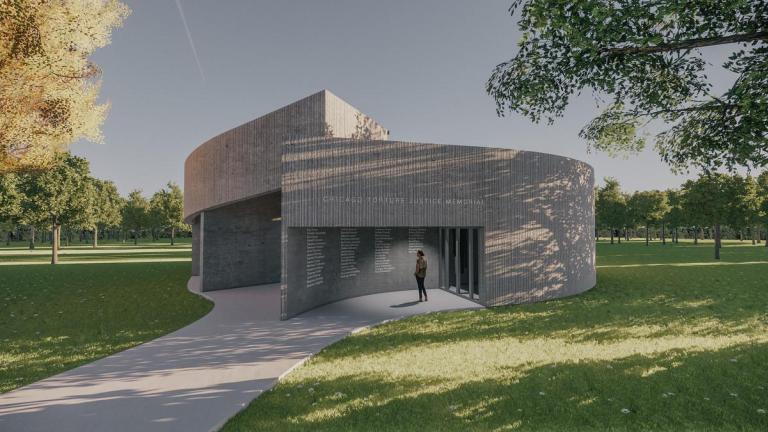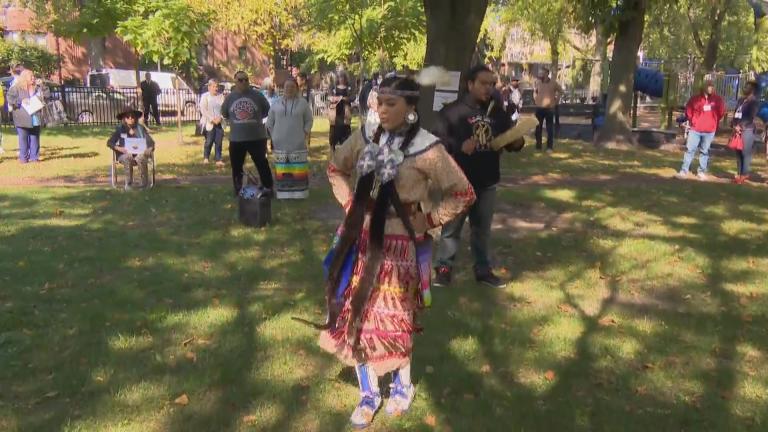For Ron Onesti, the president of Chicago’s Joint Civic Committee of Italian Americans, Mayor Lori Lightfoot’s decision to remove the city’s three statues of Christopher Columbus after violent protests was a bitter pill to swallow.
While most of the media attention focused on the city’s overnight removal of the explorer’s statue in Grant Park, Onesti found himself gutted by the removal of the statue from Arrigo Park in Little Italy.
“What was left was a gray concrete hole surrounded by a chain link fence,” Onesti said. “That was symbolically hard for our community to look at.”
So Onesti took matters into his own hands, and ordered a dozen green, red and white banners emblazoned with the pictures of prominent Italian Americans — ranging from pop superstar Madonna to Antonio Meucci, the inventor of the telephone — underneath the phrase “proud and positive.”
“You can take away our statue, but you can’t take away our pride,” said Onesti, who was born in Little Italy and has been a member of the city’s most prominent Italian American civic group for 40 years. “I couldn’t let that happen.”
But Onesti did not get a permit from the Chicago Park District before installing the display in October, which is Italian American Heritage Month — and the display will have to come down, said spokesperson Michele Lemons.
Onesti said he “meant no disrespect” to the city by installing the banners and flag without a permit. However, Onesti has yet to start taking down the banners, and in recent days added new ones even after the Park District told WTTW News they would have to be removed.
“I was just trying to turn lemons into limoncello,” Onesti said, laughing. “This was my way of protesting.”
Lemons did not respond to questions from WTTW News about why the banners were allowed to be put up without a permit or why they have not required Onesti to remove the display.
Some of the banners proved controversial, including one of former New York City Mayor Rudy Giuliani, who served as former President Donald Trump’s attorney and publicized the lie that the 2020 presidential election had been rigged.
Onesti said he replaced Giuliani’s banner after someone threw excrement at it.
The banners were not designed to be a political statement, he said.
Others took to Facebook and Twitter to object to the pictures of actors Robert De Niro and Joe Pesci, which were taken from the classic mob movie “Goodfellas,” which is reviled by some Italian Americans for trafficking in stereotypes.
Some of the banners prompted confusion, including one showing musicians Alicia Keys and Taylor Swift, who have some Italian ancestry but do not claim they are Italian American.
“We’re not just spaghetti and meatballs,” Onesti said. “I wanted to give people a source of pride at a time of uncertainty and depression.”
In response to criticism that the banners should honor Chicagoans, Onesti put up banners honoring Chicago Police Officer Joseph M. “Joe” Esposito, who died in 2011, and Little Italy community activist Oscar D’Angelo.
In all, Onesti said he spent approximately $12,000 on the 28 banners and nearly a dozen Italian flags as well as a larger American flag. The display was not approved by the Joint Civic Committee of Italian Americans, Onesti said, adding that he did it on his own.
The statue that sat in Arrigo Park — now in storage, indefinitely — represents the hard work of generations of Italian American Chicagoans, Onesti said.
Crafted in bronze by sculptor Moses Ezekiel for the Italian pavilion at the 1893 World’s Columbian Exposition, it was moved after the fair to the second story of the Columbus Memorial Building at State and Washington streets in the Loop.
When the building was torn down 1959, the statue went into storage.
But former state Rep. Victor Arrigo, a vocal advocate for the Italian American community, pushed to find a new home for the statue in the early 1960s — just as Little Italy was being transformed by the construction of the University of Illinois’ Circle Campus.
The statue would find a new home in 1966 in what was then Vernon Park, but would become Arrigo Park in 1974, a year after the lawmaker’s death.
One of the banners featured a picture of the statue’s rededication, which was attended by baseball legend Joe DiMaggio and U.S. Rep. Frank Annunzio.
It is not clear when or if any of the statues of Columbus will be returned to public display, but they were among the 40 public monuments in Chicago flagged as problematic by a commission charged by Lightfoot to conduct “a racial healing and historical reckoning project.”
Lightfoot said Tuesday she had not seen the full list of monuments being examined by the commission, and would make a decision after its work was complete.
Contact Heather Cherone: @HeatherCherone | (773) 569-1863 | [email protected]






